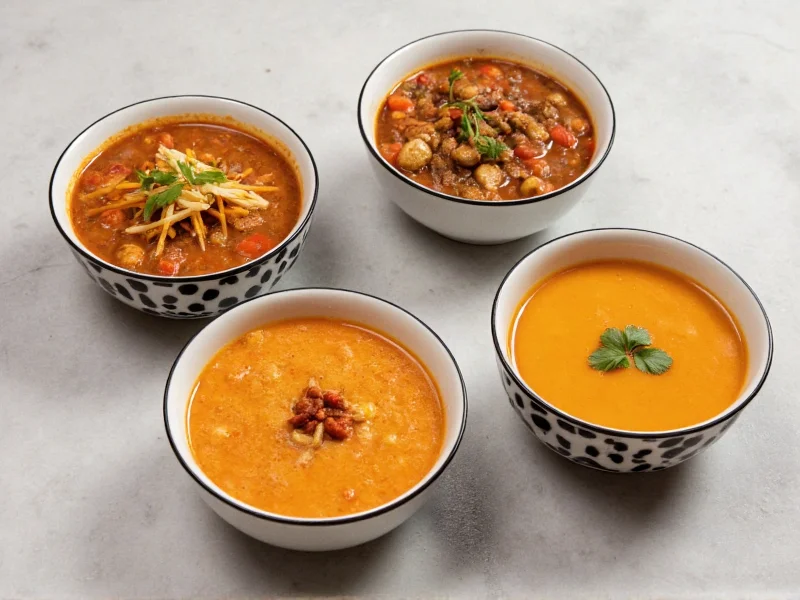Understanding the different varieties of soups helps both home cooks and culinary professionals create appropriate dishes for various occasions, dietary needs, and cultural contexts. This comprehensive guide explores each soup category in detail, providing practical knowledge for anyone interested in culinary arts or simply looking to expand their soup repertoire.
Broth-Based Soup Varieties
Broth-based soups form the foundation of soup-making across cultures. These light yet flavorful soups feature a clear liquid base made by simmering meat, poultry, fish, or vegetables with aromatics.
Traditional French soup varieties like consommé demonstrate the pinnacle of broth craftsmanship, requiring careful clarification to achieve crystal clarity. Asian culinary traditions offer numerous broth-based options including Japanese miso soup, Vietnamese pho, and Chinese hot and sour soup.
When exploring healthy broth-based soup options, consider these characteristics:
- Clear appearance with visible ingredients
- Light to medium body
- Prepared through simmering rather than boiling
- Often served as first courses in formal dining
- Can be vegetarian or meat-based
Cream-Based Soup Types
Cream-based soups provide rich, velvety textures through the incorporation of dairy or alternative thickeners. Unlike pureed soups, these varieties maintain their creamy consistency through emulsification rather than vegetable content alone.
Classic examples include cream of mushroom, cream of tomato, and vichyssoise (a cold cream-based soup). When preparing authentic cream-based varieties, chefs typically create a roux (flour and fat mixture) before adding liquid, though modern techniques often use pureed vegetables for thickening.
For those seeking vegetarian soup varieties without cream, consider using blended potatoes, cauliflower, or cashews to achieve similar richness without dairy products.
Pureed Soup Categories
Pureed soups transform cooked ingredients into smooth, homogeneous textures through blending or processing. These soups rely on their main ingredients for both flavor and body, eliminating the need for additional thickeners.
Popular pureed varieties include butternut squash soup, carrot ginger soup, and pea soup. The key to excellent pureed soups lies in proper cooking of base ingredients before blending, ensuring maximum flavor development.
When exploring traditional pureed soup recipes, note that many cultures use similar techniques with locally available ingredients, creating regional variations on this basic preparation method.
Chowders and Bisques: Understanding the Difference
Many home cooks wonder about the difference between chowder and bisque. While both are thick soups, they have distinct characteristics:
| Soup Type | Texture | Primary Ingredients | Origin |
|---|---|---|---|
| Chowder | Chunky, hearty | Seafood, potatoes, corn | New England, USA |
| Bisque | Smooth, creamy | Shellfish, cream, rice | France |
Chowders typically feature visible chunks of ingredients and a milk or cream base, while bisques are strained to achieve velvety smoothness. Authentic bisques traditionally use the shells of crustaceans to enhance flavor before straining.
Cold Soup Varieties for Summer
Cold soups provide refreshing options during warmer months and feature prominently in Mediterranean and Iberian culinary traditions. Gazpacho from Spain and ajoblanco from Andalusia represent two classic cold soup varieties that showcase seasonal produce.
When preparing cold soup varieties for summer entertaining, consider these tips:
- Allow ample chilling time (at least 4 hours)
- Balance acidity with sweetness for optimal flavor
- Use the freshest seasonal ingredients
- Consider texture contrasts with garnishes
- Adjust seasoning after chilling, as flavors change when cold
Regional Specialty Soups Around the World
Exploring regional soup specialties reveals culinary traditions shaped by local ingredients and cultural influences. Each region has developed signature soup varieties that reflect their unique food heritage.
Notable examples include:
- Borscht (Eastern Europe) - vibrant beet soup often served with sour cream
- Tom yum (Thailand) - hot and sour shrimp soup with lemongrass
- Cullen skink (Scotland) - thick smoked fish soup
- Mulligatawny (India) - curry-flavored soup with British colonial influences
- Menudo (Mexico) - tripe soup traditionally served for celebrations
When researching authentic regional soup recipes, pay attention to traditional preparation methods that often contribute significantly to the final flavor profile.
Selecting the Right Soup for Different Occasions
Understanding soup varieties helps in selecting appropriate options for various dining situations. Consider these guidelines when planning your menu:
- Formal dinners: Clear broths or elegant purees served in small portions
- Casual gatherings: Hearty chowders or regional specialties in bread bowls
- Summer events: Chilled soup varieties like gazpacho or cucumber soup
- Cold weather: Rich bisques or substantial broth-based soups with proteins
- Dietary restrictions: Modify traditional recipes using appropriate substitutions
Mastering different soup varieties requires understanding both traditional preparation methods and modern adaptations that accommodate various dietary needs while maintaining authentic flavors.
Frequently Asked Questions
What's the difference between soup and stew?
Soups typically have a higher liquid-to-solid ratio than stews. Soups are generally thinner and can be consumed primarily as a beverage, while stews have less liquid and substantial chunks of ingredients that require utensils for eating. Stews are usually cooked for longer periods at lower temperatures than most soups.
How can I thicken soup without cream?
Several effective cream alternatives exist for thickening soups. You can puree part of the soup and return it to the pot, use a roux (equal parts fat and flour), add mashed potatoes or beans, incorporate ground nuts, or use cornstarch slurry. Each method creates different textures and may slightly alter the flavor profile of your soup.
Which soups are traditionally served cold?
Several traditional cold soup varieties exist worldwide, including Spanish gazpacho (tomato-based), French vichyssoise (leek and potato), Turkish tarator (walnut and garlic), and Scandinavian fruit soups. These cold preparations often feature seasonal produce and provide refreshing options during warmer months without requiring cooking.
What defines a bisque versus other cream soups?
Authentic bisques differ from standard cream soups through their preparation method. Traditional bisques involve roasting shellfish shells to intensify flavor, pureeing the cooked ingredients until completely smooth, and straining multiple times for perfect texture. While modern usage often equates "bisque" with any creamy soup, true bisques specifically refer to smooth, creamy shellfish soups with a rich, velvety texture.











 浙公网安备
33010002000092号
浙公网安备
33010002000092号 浙B2-20120091-4
浙B2-20120091-4